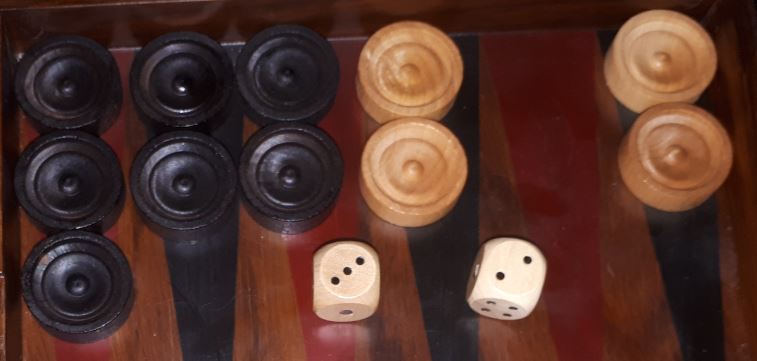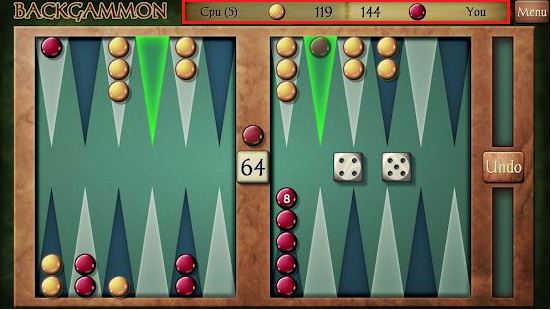Last updated on May 8, 2024
In this Deluxe Backgammon post for beginners, we take a look at the significance of the number 8, or 8.1667 to be precise, and how we can factor this number into our games. To understand this post properly you need to understand the pip count and how it is used in backgammon. Ideally, you should be able to calculate a pip count in your head. However, if you are playing online or electronically, this is normally done for you and displayed on the screen. This article looks at one way a beginner can analyse the pip count and make judgements based on the numbers. It is a simple concept to learn and apply to actual gameplay. It is all about understanding the average dice roll in backgammon.
The pip count represents the number of pips or points that a player needs to move their checkers to bear them off and win the game. At the start of play, the pip count for both players is 167. This pip count value fluctuates as play progresses. If checkers are hit the pip count can rise well above the starting value. As the games move to a close the pip counts will fall. The player with the lowest pip count, at any time in the game, is considered to have the lead. In essence, backgammon is a race to a pip count of zero.
Six-sided dice
Backgammon is an ancient game of strategy and luck that is played with two six-sided dice. Each side of the dice is marked with a number from 1 to 6. The opposing sides of the dice will always add up to a total of 7. During the game, it is the values rolled on the two dice that determine how far a player can move their checkers around the board in each turn. Backgammon is a relatively simple game to learn. The rules can be contained on a single page. Some of the tules are specifically concerned with how the dice are rolled and how the checkers move.
The numbers rolled can be split between two checkers or they can be totalled and used to move a single checker. This is assuming that the opponent has no blocking points in the way to prevent such a combination. (You can land on any point as long as it is not occupied by two or more of your opponent’s checkers). For instance, if a 1 and a 5 are rolled. Assuming there are no blocking points, the player has two options. They can move one checker one space and another one five spaces. Alternatively, one checker can be moved a total of six spaces.
Averages
Using some fairly basic maths we can calculate what our expected average move is per turn in backgammon. The simple formulas below explain the average numbers for a six-sided die. From these results, we can derive the average for two six-sided dice.
(M + L)/2 = Average
M = Maximum roll possible
L = Lowest roll possible
In the case of a six-sided die:
(6 + 1)/2 = 3.5
Alternatively, the value can be calculated by adding the numbers on each side of the dice and dividing by the number of sides.
1 + 2 + 3 + 4 + 5 + 6 = 21
21/6 = 3.5
For two dice, obviously, this value is doubled to 7. A novice could be forgiven for thinking that the number 7 could be applied to the average roll in backgammon. However, this is not the case. This is because in backgammon the roll of a double is played slightly differently from a non-double roll. A roll of a double (for example, two 3’s) awards a bonus of two extra moves.
Doubles
A roll of two 3’s means that the player has four 3’s to use and may move any combination of checkers to make the play. These extra rolls add to the mean roll value of the two dice. Because of the additional rolls awarded to a double, the actual average roll of two dice in backgammon is raised to a total of 8.1667. Note, that this excludes the opening rolls, where doubles are excluded, in this instance the average is 7.
The dice rolls can range from 2-1 (or 1-2) at the lowest, allowing a maximum movement of 3 pips, to 6-6, which results in a maximum movement of 24 pips. The 2-1 equates to less than half of the average roll and the 6-6 equates to nearly three times the average roll. Obviously, a 6-6 confers a considerable advantage as it effectively helps you reduce your pip count by two extra average rolls. The advantage of a 6-6 can also be wasted if you are trying to re-enter from the bar or if your board is crunched.
Initial set up
Imagine for a moment that your checkers are set up in the starting position with an initial pip count of 167. Your opponent’s checkers are missing and you simply have to roll the dice to move your checkers around the board without any barriers or the risk of being hit. Using the average roll of 8.1667 and ignoring wastage during bearing-off, we can expect to take between 20 – 21 rolls to clear the board (167/8.1667 = 20.4656). Some days you may roll a series of high doubles and you will clear the board in far fewer rolls. On other days you will roll the dreaded 1’s and 2’s and it will take you many more rolls to bear off. Note that this doesn’t account for situations where moves are forfeited because checkers are blocked and there are no legal moves.
However, over thousands of attempts, the dice will even out and you will clear the board in close to 20-21 rolls on average. In this example, the rollout is just a pure race against yourself and time. In a real game, there are opposing checkers and devious opponents to add complexity to the game. Blocking strategies and hitting come into play which makes navigating the board a much greater challenge.
The rule of 8
Experienced backgammon players will all monitor the pip count to determine who is ahead in the race and by how far. Some players might consider it as a percentage lead, others just a raw number. Either way, these players are using this knowledge to make tactical and strategic decisions and also for doubling considerations. There is another way of looking at the race status and that is what we at Deluxe Backgammon call the ‘rule of 8’.
We know from the calculations above that the average dice roll in backgammon equals 8.1667. For simplicity, we will round this down to 8, although some more conservative players like to roll it up to 9. A single roll is then considered to be valued at 8. To apply the rule of 8 you take the difference in the pip count between the two players and divide that value by 8. This gives you the number of rolls the player is in front or behind. For example, in the screenshot below Yellow (119) leads Red (144).
144 – 119 = 25
25/8 = 3.125
Example
In this instance, Yellow has a lead of just over three rolls, which is a considerable advantage, especially considering Red is re-entering from the bar. Depending on the state of the match, it might be an opportune time for Yellow to double. Alternatively, it might be a time to start breaking contact and race for the finish. Some players are comfortable taking chances with a small lead of one or two rolls, but others will want to have a more significant lead before committing to using the racing edge. Other things need to be taken into consideration, such as the strength of the opponent’s home board. A strong board or a closed-out board means there are dire consequences if a loose checker is hit.
As backgammon is a racing game when a checker is hit it is sent to the bar and needs to re-enter and move around the board again. This can cause you to fall behind in the race. Additionally, when a checker is hit you use at least half your roll to enter from the bar. This effectively makes it more difficult to develop your position or attack your opponent. Lastly, if you fail to re-enter, you roll and let your opponent get further ahead in the race. Because the average dice roll in backgammon is 8. Being sent to the bar will take 4+ average rolls to recover.
Guideline
If you are behind in the race you can also use the rule of 8 to dictate your defensive strategy. When you are significantly behind in a race it is usually wrong to abandon an anchor. Staying back and waiting for a shot may be your only chance to win. The other thing to remember is we are talking about an average value. A lead of two rolls evaporates quickly if your opponent rolls a 6-6 and takes the lead for themselves. Luck always plays a part in backgammon and a series of high doubles can remove all of the skill from a single game. However, the rule of 8 is generally a good guideline that can help beginners make tactical decisions. It is all about understanding the average roll of the dice in backgammon.
Related content
Rules of thumb. Overall, these rules will help to simplify your decision-making process.
Backgammon opening moves, a simple list.
Backgammon Galore, pip count definition.




“Imagine for a moment that your checkers are set up in the starting position with an initial pip count of 167. Your opponent’s checkers are missing and you simply have to roll the dice to move your checkers around the board without any barriers or the risk of being hit. Using the average roll of 8.1667 we can expect to take between 20 – 21 rolls to clear the board (167/8.1667 = 20.4656).”
This is not correct…. 20 – 21 roles does not factor inefficiencies that likely will occur in peeling off, where high roles may need to be used to remove pieces that only require lower dice values. Statistically, this means the number of roles will likely be higher.
Hi Robert,
You are correct, the rule of 8 is not an exact science and does not take into account wastage when bearing off. It also doesn’t account for situations where moves are forfeited because checkers are blocked and there are no legal moves. The rule is just a rough guide and another way to look at the pip count. It is best used during the opening and middle game stages before the complications you pointed out come into play. I have updated the post to add clarity based on your observations. Thanks for taking the time to comment and helping to improve the post, Jason
I’ve been playing backgammon for 40 years, this is an interesting new idea. In fact, outside of some interesting revelations from improved backgammon software, the rule of 8 is the first new backgammon concept I’ve heard of in all that time.